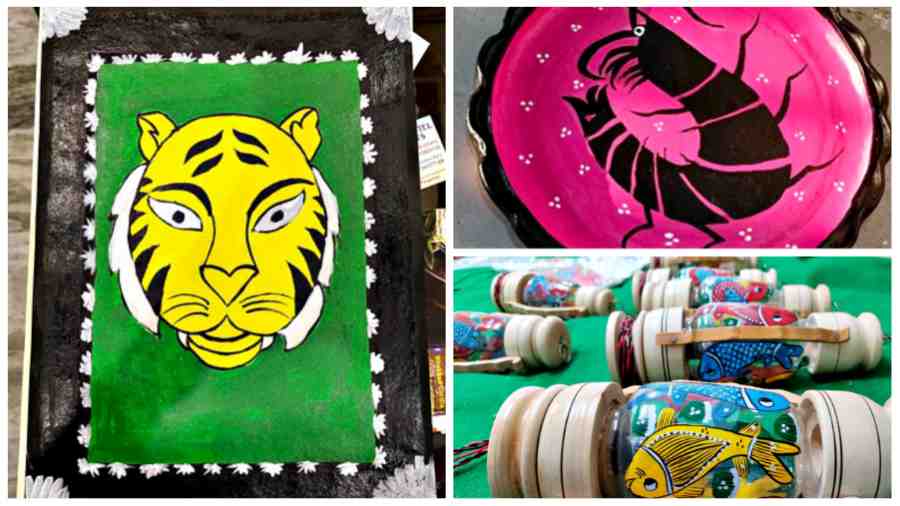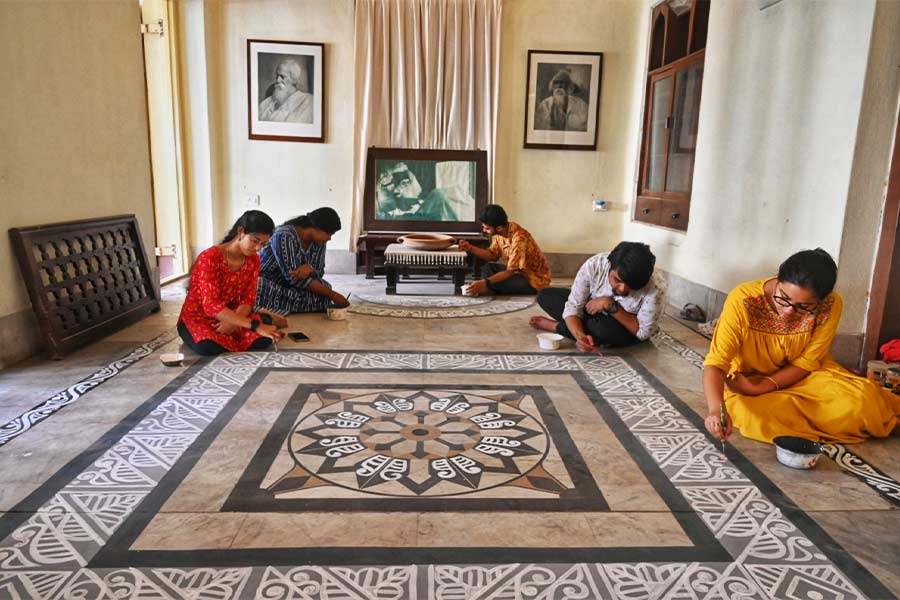A livelihood project led by local women aims to revive a long-lost art form of the land of mangroves and tigers.
Around 40 women from villages around the Sunderbans Tiger Reserve have for the past four months been trained in scroll painting (patachitra), which, organisers said, once had a vibrant history in the mangrove delta.
The training culminated in a month-long exhibition at Sajnekhali that started on Sunday.
Scrolls and paintings inspired from scroll art are being sold from one stall at the exhibition. Another is selling other merchandise — T-shirts, clay pots, kettles, and lanterns — inspired from the Sunderbans scroll painting.
A live workshop , where women are painting scrolls, is also a part of the show.
“This is the peak tourist season in the Sunderbans. We are banking on a solid footfall,” said Sourav Mukherjee of the Kolkata Society for Cultural Heritage, the NGO that trained the women and is now supporting them in marketing the products.
The training and the exhibition are funded by the Sunderbans Tiger Reserve.
“The women were selected from the joint forest management committees. We want this project to do well because that will reduce their families’ dependence on the forest,” said Ajoy Das, field director of STR.
The training, which happened at Pakhiralay of STR, was the first time most of the women picked up a brush or colours.
Some of the women had to travel for close to two hours to reach the camp. Some brought little babies along.
“I knew nothing about this patachitra. I travelled for close to two hours every day to reach the camp. I did so because I liked the work and it offered a chance to earn,” said Smritikona Mridha Mondol, who lives in a village called Dayapur in Gosaba. She walked till the riverbank, took a boat and then walked again to reach the camp. Mondol carried her one-year-old son along. Her husband is a fisherman. Like many others, he ventures into the forests risking his life to sustain his family.
“The lives of these women are extremely taxing. At the start, I was doubtful of the time they would be able to spare for art. The style of patachitra looks simple but is not. I was surprised at their dedication. They have done an incredible job,” said the trainer, Chinmoy Mukhopadhyay, a contemporary artist and illustrator focussed on Bengal folk art in general and scroll painting in particular.
Scroll painting usually sees the use of natural colours from leaves, fruits, stones and soil. But because of constraints, Mukhopadhyay and his team used acrylic and poster colours.
Patachitra, or cloth-based scroll painting, is one of the oldest folk arts of Bengal. Though there is very little written documentation of its origin, the form is believed to trace back to the 13th century. The content on the scroll ranges from mythological lore and folk tales to social sagas. Back in the days, patuas would carry the scrolls to village fairs and sing the stories painted on them.
Naya Pingla, a village in West Midnapore and home to many patuas, has shot to international fame for reviving the art form.

Items on display at the exhibition at Sajnekhali
“The patachitra of Kalighat and Midnapore are well known. But the form was once thriving in the Sunderbans as well. The local environment is inseparable from local art. The patachitra of Sunderbans drew from the tales of local legends like the Bon Bibi (the protector of humans and the forest) and the tiger,” said Mukhopadhyay.
“The absence of a sustainable revenue model possibly led to the dwindling popularity of patachitra in the Sunderbans. The scrolls did not make much headway outside the delta perhaps because of its geographical location.”
Dipankar Ghosh, author of multiple books on folk art of Bengal, said there is evidence of patua settlements in many areas of South 24-Parganas. “They lived in areas like Diamond Harbour, Mathurapur and Patharpratima. But by the 1970s, they had either moved out or their future generations had switched to other professions,” he said.
“We have come across multiple journals and other documents that offer a peek into a vibrant patachitra tradition in the Sunderbans, in the archives of the National Library,” said Mukherjee of the NGO behind the project.
“Our aim is to make this art economically viable and sustainable. These women won’t have to work in the jungle to survive if the project is commercially successful. It can be a story of women empowerment and revival of a lost art form,” he said.






